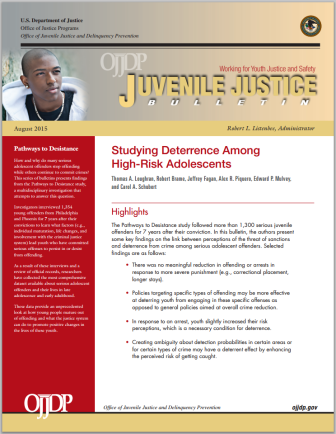 WASHINGTON — Researchers first reported several years ago that a major longitudinal study of serious adolescent offenders showed the severity of their punishments had little effect on their recidivism rates.
WASHINGTON — Researchers first reported several years ago that a major longitudinal study of serious adolescent offenders showed the severity of their punishments had little effect on their recidivism rates.
Digging into the data, the researchers also found that teenagers who commit serious crimes do respond to the threat or risk of sanctions, though not in a one-size-fits-all way.
In a new report released by the federal Office of Juvenile Justice and Delinquency Prevention, researchers say the findings point to the need to devote resources to change risk perceptions, rather than prisons.
The report, “Studying Deterrence Among High-Risk Adolescents,” is one of several OJJDP bulletins based on research from “Pathways to Desistance,” the study that followed more than 1,300 young offenders for seven years after their court involvement.
The resulting research has found no meaningful reduction in offending or arrests due to more severe punishment, such as correctional placement versus probation or longer periods of institutional placement, the researchers said. But it did find that the certainty of punishment can play a role in deterring future crimes.
Among adolescents who commit serious offenses, “recidivism is tied strongly and directly to their perceptions of how certain they are that they will be arrested,” the report said.
Edward Mulvey, the principal investigator on the Pathways study, said the idea that adolescents respond to the certainty of punishment, not severity, has found an audience with some policymakers. They are asking whether states should have to justify why the criminal justice system should hold an adolescent offender for a long time.
“It’s switching the presumption that kids should be in treatment for ‘as long as it takes,’” he said.
[Related: Rethinking Juvenile Detention: Better Outcomes With Fewer Lockups]
The new bulletin looks at how young offenders evaluate the risks of crime, which has a deterrence effect. Young people slightly increased their risk perceptions in response to an arrest, it found. The researchers said, though, there is no standard response to the certainty of punishment because risk perceptions vary based on individuals’ prior experiences or history of offenses and other factors.
Findings from the “Pathways” study have been important in shaping reformers’ policy agendas, said Sarah Bryer, director of the National Juvenile Justice Network, especially because the study focused on young people, rather than extrapolating from adults’ experiences.
“It brings home the importance of understanding young people in the context of their development trajectory,” she said.
More than 80 articles have been published based on the data, which was released between 2012 and 2014. The OJJDP bulletins, written by researchers, give an overview of what has been discovered based on the study.
In the report, the researchers highlighted policy implications including:
- Serious adolescent offenders are most likely to change their perceptions of risk if they are arrested before they have a “sizeable reservoir of offenses.”
- The offenders’ changes in perception of risk are greatest for crimes connected to their arrest. Policies that focus on certain offenses may be “marginally more effective” at reducing that crime than broad crime reduction efforts.
- If an offender is uncertain about the level of risk, that perception may be used to enhance deterrence. The police, for example, could increase the randomness of surveillance and patrol.
The last of those findings is controversial, said the researchers, because it would “require police agencies to substantially rethink how they deploy their scarce resources.”
The researchers also said there is much to learn about offenders beyond how they respond to the threat of sanctions.
“The challenge ahead in deterrence research on serious adolescent offenders is to learn more about offenders’ decisionmaking so that policies can more efficiently and effectively deter these offenders from crime,” the report said.
Brent Orrell, a vice president at ICF International who studies family and economic stability, said he would be interested to see future research that looks at how adverse childhood experiences influence perceptions of crime and punishment.
“We can tune in to what we’re learning from the neuroscience work on how trauma shapes the ability to perceive and manage risk,” he said.
More stories related to this one:
Women’s Center Works to Lower Recidivism Rates With ‘Immersion in Sisterhood’
Different Ways of Measuring Recidivism Leads to Incomplete Data, Report Says
Juvenile Recidivism Measurement Inconsistent Across States
Pennsylvania Finds 20 Percent of Juveniles Re-offend Within Two Years
Looking at the Odds for Illinois’ Youngest Offenders – and the Efforts to Arrest Recidivism

